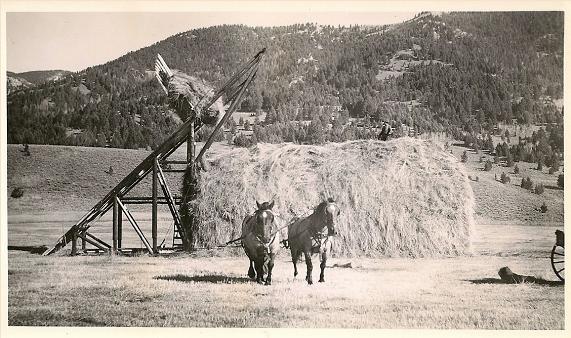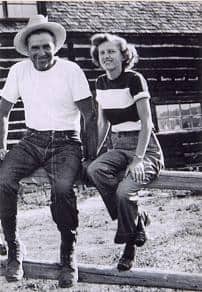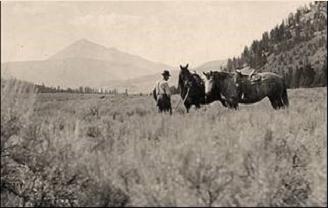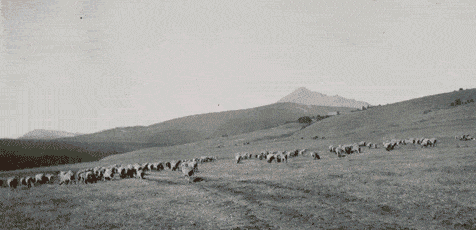historic crail ranch
History and PreservationEarly History
The Crail Family
Homestead Becomes A Ranch
The Coming of Big Sky Resort
Gallery
The Story of the Historic Crail Ranch and the Crail Ranch Homestead Museum
The Crail Ranch Homestead Museum is housed primarily in the unique log structures of the Historic Crail Ranch, some of the oldest original buildings in the Big Sky area. Historic Crail Ranch preserves the story of the Crail family and their homestead in the verdant valley meadow that is now part of Big Sky, Montana.
Beginning in the early 1900s, and continuing for more than 50 years, Crail Ranch grew from a small homestead cabin to an active ranching operation with livestock and wheat fields, ultimately encompassing 960 acres and as many as ten buildings, of which only two remain.
Preserving Historic Structures:
The charter for the Historic Crail Ranch Conservators, first put in place in 2006, lists preservation of the Historic Crail Ranch structures as a key responsibility of the Conservators.
Early History
The first visitors to the area now called Big Sky were Indians at the hunter/gatherer level who used the area for at least 9,000 years, during their seasonal search for resources.
Shoshone, Bannock, Nez Perce, Crow, and others trekked along the Gallatin Crest and camped on the Gallatin River at confluences of many creeks and tributaries to that river.
In 1806, Lewis and Clark explored the three rivers that joined to form the Missouri. They named the easternmost of those rivers after Albert Gallatin, the Secretary of the Treasury who managed the funding for their expedition. Mountain men trapped fur-bearing animals along the river and its tributaries in the early 1800s. Later a few prospectors visited the canyon to search for valuable minerals.
By the 1880s, ranchers began moving herds of sheep, cattle, and horses over the pass from the Madison Valley and up the Gallatin Canyon logging road in the summer months, seeking the meadows in the small tributary drainages.
By the late 1890s, under the provisions of the Homestead Act and the Land Revision Act, a few ranchers began building cabins and staking out 160 acre homesteads in what is now the Big Sky area. One of these homesteaders was Augustus Franklin Crail.
With the establishment of Yellowstone Park in 1872, and the coming of the railroads to the Bozeman area in the 1880s, the move to open up the Gallatin Canyon gained momentum. The first roads along the Gallatin River were cut to facilitate logging of pine trees for railroad ties.
The first visitors to the area now called Big Sky were Indians at the hunter/gatherer level who used the area for at least 9,000 years, during their seasonal search for resources.
Shoshone, Bannock, Nez Perce, Crow, and others trekked along the Gallatin Crest and camped on the Gallatin River at confluences of many creeks and tributaries to that river.
In 1806, Lewis and Clark explored the three rivers that joined to form the Missouri. They named the easternmost of those rivers after Albert Gallatin, the Secretary of the Treasury who managed the funding for their expedition. Mountain men trapped fur-bearing animals along the river and its tributaries in the early 1800s. Later a few prospectors visited the canyon to search for valuable minerals.
By the 1880s, ranchers began moving herds of sheep, cattle, and horses over the pass from the Madison Valley and up the Gallatin Canyon logging road in the summer months, seeking the meadows in the small tributary drainages.
By the late 1890s, under the provisions of the Homestead Act and the Land Revision Act, a few ranchers began building cabins and staking out 160 acre homesteads in what is now the Big Sky area. One of these homesteaders was Augustus Franklin Crail.
With the establishment of Yellowstone Park in 1872, and the coming of the railroads to the Bozeman area in the 1880s, the move to open up the Gallatin Canyon gained momentum. The first roads along the Gallatin River were cut to facilitate logging of pine trees for railroad ties.
The Crail Family
Born in Indiana in 1842, Crail came to Montana shortly after the Civil War. He worked at farming and was a freighter for a time. In 1886, he married Sallie Creek, an educated younger woman from Missouri, and together they had three children – Eugene in 1887, Emmett in 1888, and Lilian in 1896.
In December 1901, after a term as Clerk of the 9th District Court in Bozeman, Crail decided to return to ranching, purchasing a 160-acre homestead in the Gallatin Basin for $150 from Daniel Inabnit.
In the spring of 1902, Crail moved his family from Bozeman into the small cabin that is still on the property. Within a few years, the Crail family built the larger main cabin on the very site on which it sits today.
Homestead Becomes a Ranch

Crail brand registered 1906
The Crail family annexed several additional parcels under various provisions of the Homestead Act turning their small homestead into a productive ranching operation with huge hay barns, a forge, a sawmill and other ranch buildings. Crail Ranch operated as a real stock ranch longer than any other ranch in the area.
After A.F. Crail died in 1924, son Emmett worked the Ranch until 1950 and then sold to the Humes and the Boas, who operated the Ranch partly as a working ranch and partly as a dude ranch during the 1950s.

Beaverslide in action on Crail Ranch
A major change to the ranch, made by Mrs. Hume, was the relocation of the small cabin from its original location, a few yards to the west of the main cabin, to its current location.
In the early 1960s, the Humes sold the Ranch to a cattleman named Sam Smeding, who did not live in the buildings but used them as storage for his work.

Jack and Elaine Hume in the 1950s
The Coming of Big Sky Resort
Huntley’s Big Sky, Big Dream
In the late 1960s, a consortium led by retired TV newscaster Chet Huntley purchased the Crail Ranch from Smeding, intending the land to become part of the planned Big Sky Resort.
During construction of the Big Sky Resort in the early 1970s, the Crail Ranch buildings were used to house workers building the ski area and the golf course. During this time, the smaller cabin sustained a fire that nearly gutted it entirely. Evidence of the fire can still be seen on some of the exterior logs.
After the Big Sky Resort stopped using the Crail Ranch buildings, a group of Big Sky women and men secured the buildings for the community, eventually placing them on the National Register of Historic Places.
Today the Historic Crail Ranch is the centerpiece of the Crail Ranch Homestead Museum. It is maintained and operated by the Historic Crail Ranch Conservators, a volunteer committee of the non-profit (501(c)(3)) Big Sky Community Organization.
The Big Sky Owner’s Association has been around since the beginning of the Big Sky Community. In its 40+ years of history, the BSOA has had many responsibilities and assisted in the growth of the community. To honor that history BSOA staff and members created a short video. See the beginnings and growth of Big Sky through the memories of J. David Penwell, who was responsible for incorporating the association.
BSCO Public Trails
BSCO manages 23+ miles of trails that are all multi-use and multi-directional.
Ralph’s Pass (closed in winter)
Info & Maps:
Multi-Seasonal Use
The majority of BSCO trails are open year-round, barring any temporary seasonal hazard closures.
= Groomed or plowed during the winter.Note: Ungroomed / plowed trails are still open & get packed down by use.
BSCO Projects
We are always looking at opportunities to increase parklands and open spaces while further developing public recreation amenities.
Get Involved
More Ways to Give
Support a campaign, donate stock or explore naming & sponsorship opportunities.



